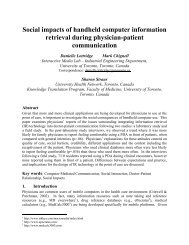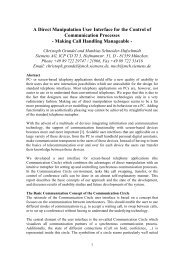Young Children and ICTs â current issues in the provision of ICT ...
Young Children and ICTs â current issues in the provision of ICT ...
Young Children and ICTs â current issues in the provision of ICT ...
You also want an ePaper? Increase the reach of your titles
YUMPU automatically turns print PDFs into web optimized ePapers that Google loves.
communications world, <strong>the</strong>n we cannot expect our children to fare better. The questions<br />
parents <strong>and</strong> child experts are ask<strong>in</strong>g are firstly how to deal with such emergent behavioral<br />
trends, <strong>and</strong> secondly what assistance can <strong>the</strong>y expect from <strong>the</strong> technologists, <strong>and</strong> o<strong>the</strong>rs, who<br />
work for <strong>the</strong> <strong>ICT</strong> product <strong>and</strong> service providers? Surely we do not advocate a strategy where<br />
<strong>the</strong> <strong>in</strong>dustry deploys, <strong>and</strong> <strong>the</strong> rest <strong>of</strong> society must deal with <strong>the</strong> consequences, however<br />
uncomfortable <strong>and</strong> worry<strong>in</strong>g <strong>the</strong>se consequences may be for our children?<br />
3. Why young children are a ‘protected market’<br />
Due to <strong>the</strong> supervisory <strong>and</strong> oversight functions <strong>and</strong> obligations <strong>of</strong> parents, <strong>the</strong> children’s<br />
market has features which are unique. In effect, without <strong>the</strong> approval <strong>of</strong> parents, it is very<br />
difficult for suppliers <strong>of</strong> any product or service targeted at young children to succeed.<br />
The market also relies to an extraord<strong>in</strong>ary extent on pester power. The customer, <strong>in</strong> this case a<br />
young child, is <strong>in</strong>sufficiently aware <strong>of</strong> <strong>the</strong> features <strong>of</strong> <strong>the</strong> product or service, because <strong>the</strong>y are<br />
too young. Thus market<strong>in</strong>g <strong>and</strong> advertis<strong>in</strong>g relies on <strong>the</strong> child’s perception <strong>of</strong> need, <strong>and</strong> on <strong>the</strong><br />
child press<strong>in</strong>g <strong>the</strong> parent hard to buy <strong>the</strong> product or service. There has been much discussion<br />
<strong>of</strong> this particular feature <strong>of</strong> this market, <strong>in</strong>clud<strong>in</strong>g possible action by various regulatory<br />
authorities to curtail <strong>the</strong> actions <strong>of</strong> suppliers <strong>of</strong> o<strong>the</strong>r, i.e. non-<strong>ICT</strong>, products. [Which? (Jan<br />
2006)] The question <strong>of</strong> <strong>the</strong> use <strong>of</strong> pester power rema<strong>in</strong>s an issue for <strong>ICT</strong> service providers.<br />
In addition to all this, it has been shown that young children need products specially designed<br />
to take account <strong>of</strong> <strong>the</strong> fact that <strong>the</strong>ir physical faculties are not yet fully developed. H<strong>and</strong>s,<br />
f<strong>in</strong>gers <strong>and</strong> eyes do not have <strong>the</strong> same characteristics as those <strong>of</strong> adults. Because <strong>of</strong> <strong>the</strong>se<br />
particular characteristics, it is better for suppliers <strong>in</strong> general to consider young children as a<br />
‘protected market’. It is clear that young children do have needs. Specifically, <strong>the</strong>y have<br />
needs, commensurate with <strong>the</strong> stage <strong>of</strong> <strong>the</strong>ir development <strong>the</strong>y have reached, for <strong>ICT</strong> products<br />
<strong>and</strong> services. However, acquisition <strong>of</strong> such products <strong>and</strong> services has to rely on purchas<strong>in</strong>g by<br />
parents. Fur<strong>the</strong>rmore, <strong>and</strong> s<strong>in</strong>ce young children cannot legally enter <strong>in</strong>to contracts, <strong>the</strong>y have<br />
to rely on <strong>the</strong> parent <strong>in</strong> this respect as well.<br />
All <strong>of</strong> this means that suppliers <strong>of</strong> <strong>ICT</strong> products <strong>and</strong> services for young children have to<br />
behave differently than <strong>the</strong>y would if <strong>the</strong> market was made up <strong>of</strong> adults. Hence <strong>the</strong> use <strong>of</strong> <strong>the</strong><br />
term protected market.<br />
4. New technologies likely to <strong>in</strong>crease <strong>the</strong> risks for young children<br />
Today’s <strong><strong>ICT</strong>s</strong> are about to be replaced <strong>and</strong> superceded by a new range <strong>of</strong> communications<br />
products <strong>and</strong> services. The next generation <strong>of</strong> <strong>ICT</strong> products <strong>and</strong> services will extend <strong>the</strong><br />
power, reach, <strong>and</strong> universality <strong>of</strong> <strong>in</strong>terwork<strong>in</strong>g <strong>and</strong> <strong>in</strong>ternetwork<strong>in</strong>g products. Pervasive <strong>and</strong><br />
ubiquitous comput<strong>in</strong>g products, embedded <strong>and</strong> wearable communicat<strong>in</strong>g devices, <strong>and</strong> ad hoc<br />
network<strong>in</strong>g technologies will br<strong>in</strong>g a paradigm shift greater than that precipitated by <strong>the</strong><br />
telephone, <strong>the</strong> <strong>in</strong>ternet <strong>and</strong> <strong>the</strong> mobile phone taken toge<strong>the</strong>r.<br />
The scope <strong>and</strong> scale <strong>of</strong> <strong>the</strong> communications pathways <strong>in</strong> today’s <strong>in</strong>formation society def<strong>in</strong>es<br />
<strong>the</strong> fundamental characteristics <strong>of</strong> <strong>the</strong> modern world. Email, chat rooms, <strong>the</strong> mobile phone,<br />
web blogg<strong>in</strong>g <strong>and</strong> <strong>the</strong> ubiquitous power <strong>of</strong> <strong>the</strong> press, <strong>and</strong> <strong>of</strong> radio <strong>and</strong> TV broadcast<strong>in</strong>g<br />
services, drive <strong>the</strong> <strong>current</strong> <strong>in</strong>formation age. Instant <strong>and</strong> worldwide <strong>in</strong>formation dissem<strong>in</strong>ation<br />
is <strong>the</strong> norm. News <strong>of</strong> earthquakes <strong>and</strong> <strong>the</strong> destructive power <strong>of</strong> hurricanes arrives <strong>in</strong> real time.<br />
Nobody with a mobile phone is out <strong>of</strong> reach <strong>of</strong> friends <strong>and</strong> family. If we now propose to<br />
change fundamentally <strong>the</strong> way <strong>the</strong> next generation <strong>of</strong> communications technologies enables








